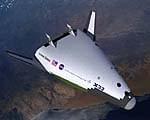Circa 2009
The futuristic thought of antimatter that is typically related to sci-fi movies may one day be able to provide propulsion to vehicles. Antimatter, is an exact oppposite copy of matter. Identical to matter, but with its electrical charge completely opposite of the original matter. Think of a battery with a positive and negative pole. The positive pole repsresenting matter, and the negative pole representing antimatter.
Antimatter is the exact oposite of matter. A definition as provided by Wikipedia concludes that antimatter is composed of antiparticles in the same way that normal matter is composed of particles. For example, an antielectron (a positron, an electron with a positive charge) and an antiproton (a proton with a negative charge) could form an antihydrogen atom in the same way that an electron and a proton form a normal matter hydrogen atom. Furthermore, mixing matter and antimatter would lead to the annihilation of both in the same way that mixing antiparticles and particles does, thus giving rise to high-energy photons (gamma rays) or other particle–antiparticle pairs.
Seems like a bunch of info for the physicists out there. But where does antimatter come in for vehicle propulsion and how does it apply to electric vehicles. The violent explosion created when matter and anitmatter collide results in considerable energy in the form of movement of protons and electrons similar to the proces of electricity moving, though at a signifacntly higher rate. This explosion, if harnessed correctly could provide thrust to a vehicle.
